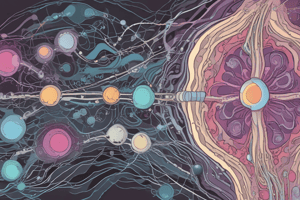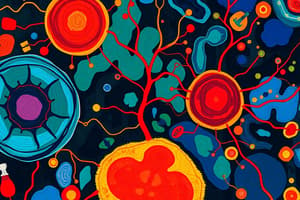Podcast
Questions and Answers
What type of signaling involves a signaling and responding cell being the same?
What type of signaling involves a signaling and responding cell being the same?
- Autocrine signaling (correct)
- Endocrine signaling
- Paracrine signaling
- Contact-dependent signaling
Which of the following best describes paracrine signaling?
Which of the following best describes paracrine signaling?
- Signals that bind to the same cell for response
- Signaling that promotes cell growth
- Signaling over long distances through the bloodstream
- Small, water-soluble signals that affect neighboring cells (correct)
Which of the following is NOT a requirement for cell signaling?
Which of the following is NOT a requirement for cell signaling?
- Responding cell
- Signaling molecule
- Receptor protein
- Extracellular matrix (correct)
In which type of signaling do signals primarily travel through the bloodstream?
In which type of signaling do signals primarily travel through the bloodstream?
What does PDGF stand for in the context of cell signaling?
What does PDGF stand for in the context of cell signaling?
Which type of signaling involves a ligand binding to a receptor on a different cell?
Which type of signaling involves a ligand binding to a receptor on a different cell?
When a cell produces a signaling molecule and a receptor that binds to it is located on the same cell, which option describes this situation?
When a cell produces a signaling molecule and a receptor that binds to it is located on the same cell, which option describes this situation?
Which is a primary example of contact-dependent signaling?
Which is a primary example of contact-dependent signaling?
What role does cAMP play in the adrenaline signaling pathway?
What role does cAMP play in the adrenaline signaling pathway?
What happens to the receptors when the concentration of adrenaline declines?
What happens to the receptors when the concentration of adrenaline declines?
How do phosphatases contribute to signal termination in the adrenaline signaling pathway?
How do phosphatases contribute to signal termination in the adrenaline signaling pathway?
What triggers the kinase cascade in the MAP kinase pathway?
What triggers the kinase cascade in the MAP kinase pathway?
What can cause excessive cell proliferation associated with some cancers?
What can cause excessive cell proliferation associated with some cancers?
What effect does ligand binding have on ligand-gated ion channels?
What effect does ligand binding have on ligand-gated ion channels?
Which statement about insulin receptor kinases is correct?
Which statement about insulin receptor kinases is correct?
What is a primary consequence of Ras being constitutively bound to GTP?
What is a primary consequence of Ras being constitutively bound to GTP?
What is the primary reason that paracrine signaling may not activate the responding cell?
What is the primary reason that paracrine signaling may not activate the responding cell?
How does a cell respond when surface proteins are stripped away and a specific signaling molecule is added?
How does a cell respond when surface proteins are stripped away and a specific signaling molecule is added?
Which type of receptor is active only when a ligand is bound to it?
Which type of receptor is active only when a ligand is bound to it?
Which of the following represents a mechanism of action for intracellular receptors?
Which of the following represents a mechanism of action for intracellular receptors?
What role does cAMP serve in signaling from G protein-coupled receptors?
What role does cAMP serve in signaling from G protein-coupled receptors?
In which situation would a ligand-gated ion channel typically respond?
In which situation would a ligand-gated ion channel typically respond?
What is a key characteristic of receptor kinases?
What is a key characteristic of receptor kinases?
Which statement accurately describes the interaction between ligands and receptors?
Which statement accurately describes the interaction between ligands and receptors?
Study Notes
Cell Communication in Multicellular Life
- Signaling cell: produces the signaling molecule
- Signaling molecule: binds to the receptor on a responding cell
- Receptor protein: binds to the signaling molecule
- Responding cell: produces a response to the signaling molecule
Cell Signaling Steps
- Signaling molecule: also known as a ligand
- Signaling cell: produces the signaling molecule
- Receptor: binds to the signaling molecule
- Responding cell: receives the signal
Types of Signals
- Endocrine signaling: long distance signaling
- Example: adrenaline, estrogen, testosterone
- Paracrine signaling: short distance signaling
- Example: growth factors, platelet-derived growth factor (PDGF)
- Autocrine signaling: the signaling and responding cell are the same
- Important in embryonic development
- Contact-dependent signaling: transmembrane protein in one cell acts as a signal and binds to a receptor on another cell
- Example: Delta-Notch signaling in development
Receptors
- Receptors: proteins that bind signaling molecules
- Can be found inside or on the cell surface
- Ligand: signaling molecule that binds to the ligand-binding site of the receptor
- When a ligand binds to a receptor, the receptor undergoes a conformational change and is activated.
Intracellular Receptors
- Nonpolar molecules: can cross the membrane and bind to receptors in the cytoplasm or nucleus
- Steroid hormones: are an example of nonpolar molecules that bind to intracellular receptors
Cell-Surface Receptors
- Polar ligands: cannot cross the membrane and must bind to cell-surface receptors
- The receptor-ligand complex undergoes a conformational change and the receptor is activated
Types of Cell-Surface Receptors
- G protein-coupled receptors
- Receptor kinases
- Ion channels
G Protein-Coupled Receptors
- Inactive until bound by a ligand
- When a ligand binds, the receptor can bind to a G protein
- G protein: activated when the receptor is bound by a ligand
- Second messenger: cAMP in the case of heart muscle stimulation
Receptor Kinases
- When a ligand binds, the receptor kinase dimerizes and phosphorylates another protein
- Examples: insulin, wound healing
Ligand-Gated Ion Channels
- Alter the flow of ions across the membrane
- When a ligand binds to an ion channel, the channel opens and ions can flow across the membrane
Cell Signaling and Cancer
- Some cancers can form when a signaling molecule is overproduced or produced in altered forms
- Example: mutations that make Ras always bound to GTP can cause 30% of cancers
- Some cancers can be caused when a receptor remains bound to its ligand
- An excess of receptors can also cause cancer because there is an increase in cellular response
Studying That Suits You
Use AI to generate personalized quizzes and flashcards to suit your learning preferences.
Related Documents
Description
Explore the intricate mechanisms of cell signaling in multicellular organisms. This quiz covers various types of signals, including endocrine, paracrine, autocrine, and contact-dependent signaling. Test your knowledge on how signaling molecules and receptors facilitate communication between cells.




